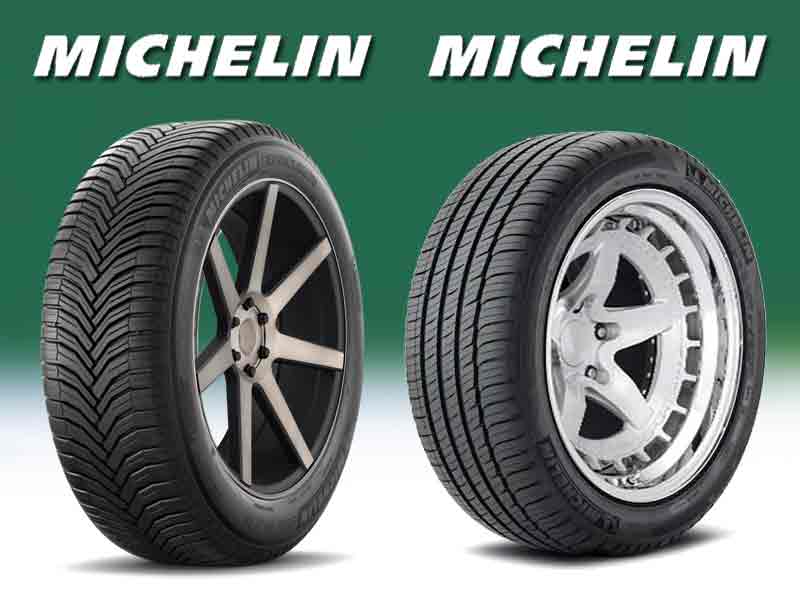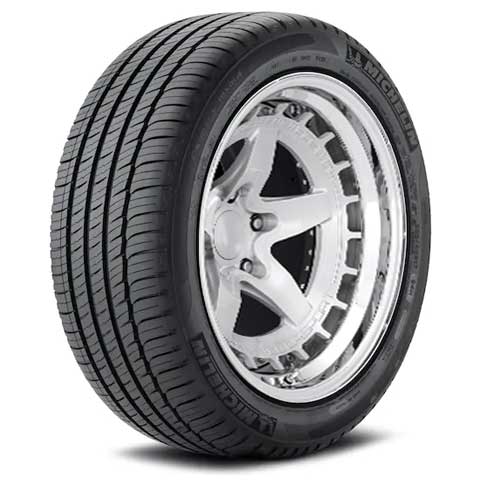For those seeking remarkable wet weather performance, the decision often boils down to the Michelin CrossClimate 2 and the Michelin Primacy MXM4. Each of these models delivers excellent traction and control, even in the most challenging conditions. Let’s delve into their specifics.
Although both tires are great, there are still some areas for Improvement, for both.

- For Michelin CrossClimate 2, improvements could be made in wet traction, noise management, and fuel consumption due to limited siping, a louder tread pattern, and a softer rubber compound, leading to higher rolling resistance.
- For Michelin Primacy MXM4, enhancements could be made in directional grip, winter performance, ride comfort, and tread life due to less packed central lugs, lack of features conducive to winter conditions, a more rigid top rubber layer, and shorter tread depth.
Table of Contents
Test Scores – Out of 10
| Primacy MXM4 | Crossclimate 2 | |
| Dry Traction | 7 | 8 (Better) |
| Wet Traction | 8 (Better) | 7 |
| Snow Traction | 7 | 9 (Better) |
| Ice Traction | 7 | 9 (Better) |
| Fuel Efficiency | 7 | 7 |
| Tread Life | 7 | 8 (Better) |
| Ride Comfort | 8 (Better) | 7 |
Design Comparison
The Michelin CrossClimate 2 offers an expertly crafted directional tread pattern, where it showcases extended arms that weave together, facilitating superior snow and water displacement abilities.

The tire’s lugs are neatly split by longitudinal indentations, distinguishing the central area from the shoulder sections.
Where the shoulders are more spaced apart, and also have less of the overall tread features. I mean, you can only see thick siping on them, and that’s it.
The rest of the features are all on the central lugs.
These lugs have snow vices, and a mixture of interlocking and rectilinear sipes.
On the other side, the Michelin Primacy MXM4 provides a asymmetrical tread pattern.

It’s tread is made up of 5 total ribs, which form very straight forward running longitudinal channels.
The central 3 ribs, form in-groove notches, along with interlocking sipes. And all these ribs are continuous running, meaning, the lateral cuts in them don’t go all the way (laterally). So no proper block formation is seen on them.
Though shoulder lugs are different, as they have curving lateral grooves. And yes, these lugs are the biggest on the tread, which explains the tire’s superb dry handling.
Wet Traction
In terms of wet surface performance, the Michelin Primacy MXM4 emerges as the superior choice, as the tire offers an array of biters made up of sipes, notches, and chamfered edges.
But why are those important? Well because sipes work by sucking up water particles in, allowing the surface to get slightly dried up.
This relatively dried up surface is then better met withe the rubber/biters of the tire.
The Michelin Crossclimate 2 on the other hand only has limited overall siping, so it lacks in providing as much of the overall wet grip.
Though the tire still offers superior resistance to aquaplaning, where its directional design facilitate quicker water evacuation.
(Basically grooves provide hydroplaning resistance, while sipes provide grip, these are the two main wet performance factors to always consider).
Grip and Handling
Traction in dry conditions is primarily characterized by two types of gripping forces, where one is just called grip, which is actually directional grip, and the other is handling (which is the tire’s sideways grip).
Now for the directional grip (which is assessed via braking distances), the Michelin Crossclimate 2 performs exceptionally well.
Comparatively, its tighter and more packed up lugs in its central region contribute to enhanced road-surface contact, resulting in reduced braking distances (calculated on average, on tests).
Basically, when a tire rolls straight, the bulk of the weight is concentrated in the middle portion of the tread, and Crossclimate 2 with its rounded contact patch, and closed up lugs there gets to be better.
On the other side, the Michelin Primacy MXM4 shows superior performance in the handling department.
Handling or the tire’s lateral traction depends on shoulders, as those bear the most weight, as the tire turns (mainly because of inertia).
Now this tire not only offers more closed up shoulder blocks, but they also don’t bend as much with the ground (as the tire corners, mainly because of its lighter weight).
This less susceptibility of its lugs flexing allows it to have a more balanced under and oversteering capabilties, which naturally improves its handling times on laps.
Winter Performance
For winter conditions, the CrossClimate 2 holds the crown, where its directional pattern is what’s helping it, the most.
It’s elongated lugs function as snow shovels, expertly handling slush and snow, generating a forward thrust that surpasses the Primacy MXM4, even though both tires bear the 3 Peak Mountain Snowflake (3PMSF) rating.
Moreover, its lugs with snow vices, allow for superior snow grabbing abilities, where the tire’s narrower and rounded contact patch, and heavier weight also help (lodging the snow particles in).
This basically offers superior snow to snow connection (which is significant as snow likes to stick on snow, instead of tread’s rubber).
Fuel Consumption
Tire fuel consumption is primarily dictated by rolling resistance, and both the Primacy MXM4 and CrossClimate 2 exhibit high resistance values.
However, in tests, the Primacy MXM4 still gets to perform slightly better due to its stiffer rubber compound, which reduces road friction by limiting lug flex and bend, thereby conserving energy.
Conversely, the CrossClimate 2, with its softer compound, uses up more fuel energy in to molding up its elongated lugs, where it’s heavier weight isn’t helping either.
Feel of Ride
Ride quality is a composite of several factors, including noise levels and the ability to cushion road irregularities. Let’s dissect each aspect.
Tread Noise
Visualize the tire tread as a concert hall, where air reverberates due to the clapping audience. This phenomenon, known as in-groove resonance, is directly proportional to air entering the tread (mostly through shoulder area).
Now here, the Michelin Primacy MXM4 does pretty great, as it employs blockers between the shoulder lugs to restrict air entry.
And less air means less collision of air particles with the tread walls.
On the other side, the Crossclimate 2 is also not too bad, as it offers streamlined directional pattern, where its lugs prevents air particles from striking the walls, too much.
Though still, the tire is louder in comparison.
On-Road Vibrations
The overall ride comfort is greatly influenced by the tire’s internal and external composition, and it makes sense why would tires with softer built would generally provide smoother ride.
That’s why here, the CrossClimate 2 shines with a softer, silica-rich tread rubber and a more pliable inner cap ply, which soak up bump more nicely.
Moreover, the tire also features greater tread depth, so there’s more rubber cushion between the bumps and the driver.
On the other hand, the Primacy MXM4 although has a flexible internal polyester casing, its rubber top is more rigid, comparatively.
So you get a relatively bumpier ride in this tire’s case. Though as mentioned in the traction section, the tire offers superior steering response, and that is also considered a comfort thing by some folks.
Tread Life
Tire longevity, or tread life, is determined by the tire’s structural design, tread pattern, and rubber composition.
And here, the Michelin Primacy MXM4 is lacking behind (slightly).
The tire although has a stiffer rubber top layer, its overall composition is still not as well engineered for durability and prolonged tread life, as its counterpart.
Moreover, the Michelin Crossclimate 2 gets to have deeper tread voids, which means it would take longer to wear down to 2/32″ of legal tread depth limit.
So it makes sense why this tire has the Uniform Tire Quality Grading (UTQG) of 640, compared to the Primacy MXM4’s UTQG of 500.
To Conclude
Michelin Crossclimate 2 excels in:
- Directional Grip: Its more packed central lugs and rounded contact patch offer superior grip, demonstrated by shorter braking distances.
- Hydroplaning Resistance: Despite limited siping, the tire’s directional design allows for better hydroplaning resistance.
- Winter Performance: Its directional pattern, elongated lugs, snow vices, narrower and rounded contact patch, and heavier weight contribute to superior performance in winter conditions.
- Ride Comfort: With a softer, silica-rich tread rubber, a more pliable inner cap ply, and greater tread depth, the ride is smoother, effectively absorbing bumps.
- Tread Life: Superior tread life is offered through deeper tread voids, reflected in a higher UTQG of 640.
Michelin Primacy MXM4 excels in:
- Handling: With more closed-up shoulder blocks and lower weight, lug flex during turns is reduced, offering superior handling times.
- Wet Traction: An array of sipes, notches, and chamfered edges provide better grip on wet surfaces.
- Tread Noise: Employing blockers between shoulder lugs restricts air entry, thereby reducing noise.
- Fuel Consumption: Despite high rolling resistance, its stiffer rubber compound conserves energy, performing better in fuel consumption tests.